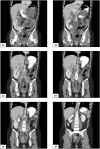Adult intestinal malrotation presenting as caecal volvulus with incidental findings of duplicate inferior vena cava and other rare abnormalities: case report
- PMID: 38463733
- PMCID: PMC10924739
- DOI: 10.1093/jscr/rjae132
Adult intestinal malrotation presenting as caecal volvulus with incidental findings of duplicate inferior vena cava and other rare abnormalities: case report
Abstract
Intestinal malrotation and duplication of the inferior vena cava are rarely diagnosed in adult patients; however, incidence is likely underestimated as they are usually asymptomatic. These congenital malformations have been previously reported in the same patient twice but never with colonic obstruction or ischaemia. A 25-year-old female presented with nausea, vomiting, obstipation, and abdominal pain, and on computed tomography of the abdomen and pelvis was diagnosed with a caecal volvulus and pneumatosis coli associated with intestinal malrotation requiring emergency right hemicolectomy. Incidentally, the patient was noted to have duplication of the inferior vena cava, azygos continuation of the inferior vena cava, and splenic fragmentation. This constellation of symptoms has not been reported in the literature previously. The pattern of malformations follows that of polysplenia syndrome. Although rare, awareness of these malformations can be useful to clinicians.
Keywords: caecal volvulus; duplicate inferior vena cava; intestinal malrotation; polysplenia syndrome.
Published by Oxford University Press and JSCR Publishing Ltd. © The Author(s) 2024.
Conflict of interest statement
None declared.
Figures


Similar articles
-
Incidental adult polysplenia with situs inversus, interrupted inferior vena cava with azygos continuation, patent ductus arteriosus, and aortic branches variations: a case report.J Thorac Dis. 2018 Feb;10(2):E138-E141. doi: 10.21037/jtd.2018.01.128. J Thorac Dis. 2018. PMID: 29607204 Free PMC article.
-
[Duplication of the superior vena cava and other malformations discovered at insertion of a port-a-cath].Rev Pneumol Clin. 2005 Sep;61(4 Pt 1):275-8. doi: 10.1016/s0761-8417(05)84826-6. Rev Pneumol Clin. 2005. PMID: 16208194 French.
-
Preduodenal portal vein, intestinal malrotation, polysplenia, and interruption of the inferior vena cava: a review of anatomical anomalies associated with gastric cancer.Surg Radiol Anat. 2012 Mar;34(2):179-86. doi: 10.1007/s00276-011-0894-7. Epub 2011 Nov 12. Surg Radiol Anat. 2012. PMID: 22080108 Review.
-
Polysplenia with situs inversus totalis, azygos continuation of the inferior vena cava, and duplication of the superior vena cava in a healthy adult: A case report.Radiol Case Rep. 2024 Jul 20;19(10):4184-4189. doi: 10.1016/j.radcr.2024.06.067. eCollection 2024 Oct. Radiol Case Rep. 2024. PMID: 39101022 Free PMC article.
-
[Duplication of the vena cava inferior with a continuation into the vena azygos. A report of a rare case].Minerva Chir. 1999 Apr;54(4):261-5. Minerva Chir. 1999. PMID: 10380526 Review. Italian.
References
-
- Gamblin TC, Stephens RE Jr, Johnson RK, Rothwell M. Adult malrotation: a case report and review of the literature. Curr Surg 2003;60:517–20. - PubMed
-
- Ng WT, Ng SSM. Double inferior vena cava: a report of three case. Singapore Med J 2009;50:211–3. - PubMed
-
- Coskun A, Okur N, Ozdemir O, et al. . Uterus didelphys with an obstructed unilateral vagina by a transverse vaginal septum associated with ipsilateral renal agenesis, duplication of inferior vena cava, high-riding aortic bifurcation, and intestinal malrotation: a case report. Fertil Steril 2008;90:2006.e9–11. - PubMed
-
- Flue M, Herzog U, Ackermann C, et al. . Acute and chronic presentation of intestinal nonrotation in adults. Dis Colon Rectum 1994;37:192–8. - PubMed
Publication types
LinkOut - more resources
Full Text Sources

